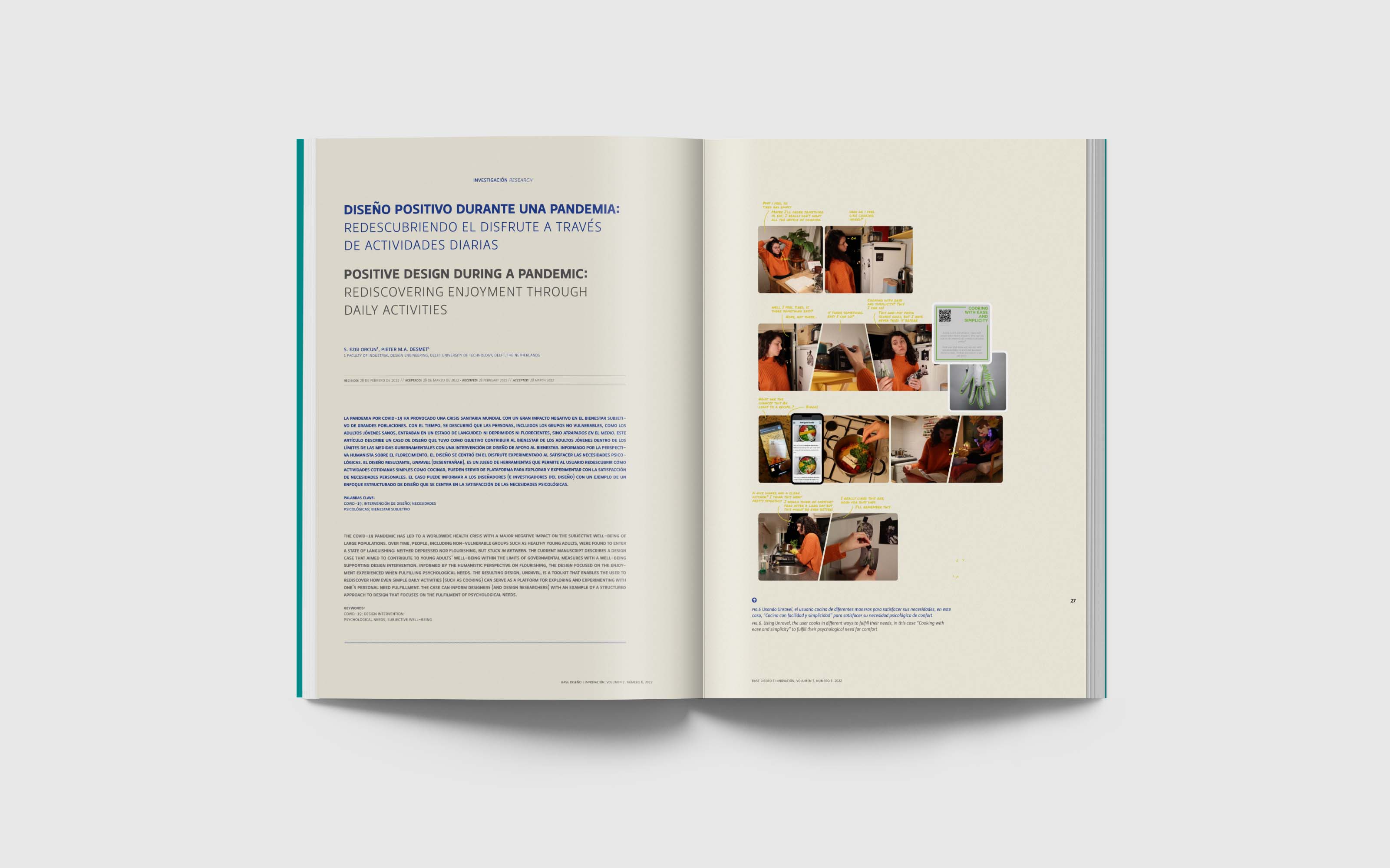Diseño positivo durante una pandemia Redescubriendo el disfrute a través de actividades diarias
Contenido principal del artículo
Resumen
La pandemia por COVID-19 ha provocado una crisis sanitaria mundial con un gran impacto negativo en el bienestar subjetivo de grandes poblaciones. Con el tiempo, se descubrió que las personas, incluidos los grupos no vulnerables, como los adultos jóvenes sanos, entraban en un estado de languidez: ni deprimidos ni florecientes, sino “atrapados en el medio”. Este artículo describe un caso de diseño que tuvo como objetivo contribuir al bienestar de los adultos jóvenes dentro de los límites de las medidas gubernamentales con una intervención de diseño de apoyo al bienestar. Informado por la perspectiva humanista sobre el florecimiento, el diseño se centró en el disfrute experimentado al satisfacer las necesidades psicológicas. El diseño resultante, “Unravel” (desentrañar), es un juego de herramientas que permite al usuario redescubrir cómo incluso las actividades diarias simples (como cocinar) pueden servir como plataforma para explorar y experimentar con la satisfacción de necesidades personales. El caso puede informar a los diseñadores (e investigadores del diseño) con un ejemplo de un enfoque estructurado de diseño que se centra en la satisfacción de las necesidades psicológicas.
Detalles del artículo
Citas
Berg, J. (2021, 21 May). Younger Americans more likely to be languishing than older Americans. Ipsos U.S. Mental Health 2021 Report. Retrieved from https://www.ipsos.com/en-us/news-polls/ipsos-us-mental-health-2021-report
Desmet, P., & Fokkinga, S. (2020). Beyond Maslow’s pyramid: introducing a typology of thirteen fundamental needs for human-centered design. Multimodal Technologies and Interaction, 4(3), 38. https://doi.org/10.3390/mti4030038
Grant, A. (2021, May 5). There’s a Name for the Blah You’re Feeling: It’s Called Languishing. The New York Times. https://www.nytimes.com/2021/04/19/well/mind/covid-mental-health-languishing.html
Keyes, C. L. (2002). The Mental Health Continuum: From Languishing to Flourishing in Life. Journal of Health and Social Behavior, 43(2), 207–222. https://doi.org/10.2307/3090197.
Keyes, C. L. M. (2003). Complete mental health: An agenda for the 21st century. In C. L. M. Keyes & J. Haidt (Eds.), Flourishing: Positive psychology and the life well-lived (pp. 293–312). American Psychological Association. https://doi.org/10.1037/10594-013
Lyubomirsky, S., Sheldon, K. M., & Schkade, D. (2005). Pursuing Happiness: The Architecture of Sustainable Change. Review of General Psychology, 9(2), 111–131. https://doi.org/10.1037/1089-2680.9.2.111
Mascherini G, Catelan D, Pellegrini-Giampietro DE, Petri C, Scaletti C, Gulisano M (2021) Changes in physical activity levels, eating habits and psychological well-being during the Italian COVID-19 pandemic lockdown: Impact of socio-demographic factors on the Florentine academic population. PLoS ONE 16(5): e0252395. https://doi.org/10.1371/journal.pone.0252395
Maslow, A.H. (1987). Motivation and Personality, 3rd ed. Longman.
Orçun, E. (2021). Designing for Well-being in the context of Covid-19: Converting daily activities into [un]conscious pursuits of joy (Master Thesis). Delft: Technische Universiteit Delft.
Ruiz-Frutos, C., Ortega-Moreno, M., Allande-Cussó, R., Domínguez-Salas, S., Dias, A., & Gómez-Salgado, J. (2021). Health-related factors of psychological distress during the COVID-19 pandemic among non-health workers in Spain. Safety Science, 133, 104996. https://doi.org/10.1016/j.ssci.2020.104996
Sheldon, K. M., Elliot, A. J., Kim, Y., & Kasser, T. (2001). What is satisfying about satisfying events? Testing 10 candidate psychological needs. Journal of Personality and Social Psychology, 80(2), 325–339. https://doi.org/10.1037/0022-3514.80.2.325
Tay, L. & Diener, E. (2011). Needs and subjective well-being around the world. Journal of personality and social psychology, 101(2), 354–365.


